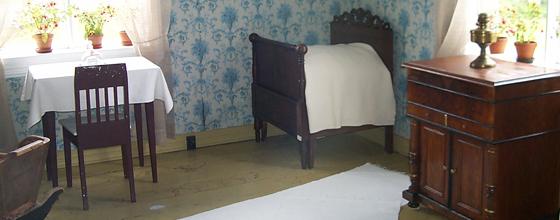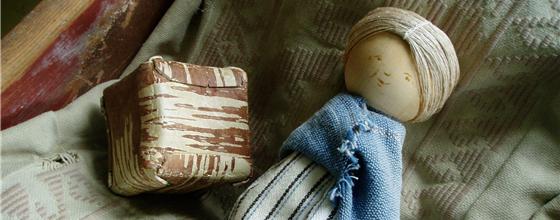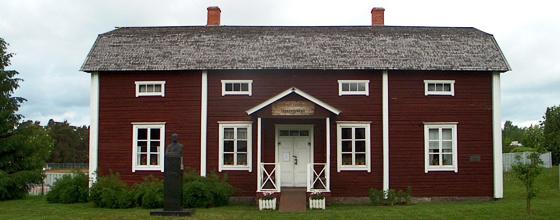Welcome to Haapajärvi
Additional information
Address:
Ronkaalankuja 4
85800 Haapajärvi
Call us:
358444456201
Familiarize:
The location’s web page
President K.J. Ståhlberg’s Childhood Home Museum
President K.J. Ståhlberg’s (1865-1952) childhood home museum is located in Haapajärvi, at Ronkaalankuja 4.
Reservations and inquiries: Cultural producer, phone number +358 44 4456 201
Kaarlo Juho Ståhlberg (1865–1952) – Childhood and Youth
“I, for my part, have my first childhood memories from Haapajärvi, and those bonds do not disappear as I wander elsewhere.”
K.J. Ståhlberg had the famous Finnish clergy and official blood running in his veins, as he descended from families such as Castrén, Cajanus, and Snellman, on both his father’s and mother’s sides.
When K.J. Ståhlberg was born in 1865, the family’s father, Johan Gabriel Ståhlberg, served as the chaplain in Alavieska. The family, including the father, Kaarlo Juho, mother Amanda Gustafva Castrén, sister Alma, and later also brother Fredrik, moved to Haapajärvi when Kaarlo Juho was four years old in 1869.
The Ståhlberg family arrived in Haapajärvi immediately after the great famine years. Life in the late 19th-century rectory was quite modest, but despite this, life and childhood in Haapajärvi left an indelible mark on K.J. Ståhlberg. During their childhood in the rectory, Kaarlo Juho and his siblings adopted ideas such as equality and the Finnish language, playing on equal terms with other children.
K.J. Ståhlberg’s father, Johan Gabriel Ståhlberg, did not serve the Haapajärvi parish for long, as the call to eternity came in 1873. J.G. Ståhlberg’s grave is located near Haapajärvi church. Life without the family head was challenging, as the mother remained in Haapajärvi alone with four underage children. Kaarlo Juho spent his childhood in Haapajärvi until 1877 when his mother Amanda Gustafva sent the fifteen-year-old Kaarlo Juho and his sister Alma to school in Oulu.
Once on the path of education, Kaarlo Juho quickly became a very intelligent and ambitious student. While studying at the Finnish private lyceum in Oulu, he was the top student in his class every year. Raised as a Finnish-speaking and minded individual, K.J. Ståhlberg chose to attend a Finnish-language lyceum, a rare choice for a young man from a clergy family at the time. He graduated with excellent grades in 1884: he received the highest grade, laudatur, for his matriculation examination, and his overall average was very high for that time, 9.20.
K.J. Ståhlberg completed university studies, earning a Bachelor of Arts in 1887, a Bachelor of Laws in 1889, and a Doctorate in 1893 with a thesis on “Vagrancy According to Finnish Law.” During his student years, Ståhlberg was actively involved in the liberal political group Valvoja of the Young Finnish Party. Due to his versatility and competence, K.J. Ståhlberg worked as both a Swedish language teacher in a high school and as the editor-in-chief of the Finland magazine.

Career and Presidency
Throughout his career, K.J. Ståhlberg worked in various positions. After completing his studies, he served, among other roles, as the protocol secretary of the Senate’s Civil Service Commission (1898–1903), the assistant clerk of the Helsinki City Finance Chamber (1903–1905), and the head of the Senate’s Trade and Industry Service Commission in 1905–1907.
K.J. Ståhlberg also worked as a professor and member of parliament during his career. He was appointed as a professor of administrative law in 1908, and he held this position until 1918. During this time, Ståhlberg authored his most significant work, “Finnish Administrative Law I and II,” which was a crucial textbook for the Faculty of Law for a long time. Ståhlberg was elected Speaker of Parliament in 1914. In the constitutional debate on the form of the future Finnish state, K.J. Ståhlberg was selected as the chairman of the Constitutional Committee and the Constitutional Committee in 1917.
In 1919, when Finland elected its first president, K.J. Ståhlberg still served as the president of the Administrative Court. Ståhlberg himself was confident about Mannerheim’s election, and he had not originally prepared for the role of the head of state. The votes in the presidential election between Ståhlberg and Mannerheim went in favor of Ståhlberg with a vote of 143–50. Upon the announcement of the presidential election results, Ståhlberg made a solemn declaration in the parliament, stating, among other things:
“According to the constitution of the Finnish Parliament, I must follow the decision made by the Finnish Parliament. I must take on the responsible duty of the President of the Republic of Finland.”
During K.J. Ståhlberg’s presidency (1919–1925), the challenges of newly independent Finland played a significant role. The monarchists, who were left behind in the form of government dispute, caused headaches for Finland’s first president, and the relationship with Mannerheim remained distant and cool. Especially the monarchists did not care much for Ståhlberg – as a lawyer and stiffly behaved Finnish Fenno-maniac, Ståhlberg was compared in harsh terms to Mannerheim, who was above all an experienced world traveler, warrior, and adept at court etiquette.
After his presidency, Ståhlberg worked, among other roles, as a senior member of the legislative drafting committee (1926–1946). K.J. Ståhlberg was also close to being elected president again in 1931 and 1937 – for example, in the 1931 presidential elections, K.J. Ståhlberg lost the presidency with the narrowest possible margin (149–150) to Pehr Evind Svinhufvud.

Sources
Biographical Center, Finnish Literature Society: Ståhlberg, Kaarlo Juho (1865–1952).
Finnish Heritage Agency: Nationally Significant Built Cultural Environments RKY: Haapajärvi Church Shore.
Virma Library: K. J. Ståhlberg.
President K.J. Ståhlberg’s Childhood Home brochures and information provided by Juha Eronen about K.J. Ståhlberg and Ronkaala Rectory.
Ronkaala Rectory
Built in 1784, Ronkaala Rectory has served as Kaarlo Juho Ståhlberg’s childhood home. It is currently located in its original location near Haapajärvi Parish House and Church.
The rectory building has experienced a lot over the years. After both the children and Mrs. Ståhlberg had moved to Oulu, Haapajärvi Parish sold the vacant Ronkaala Rectory to the municipality in 1898 for a redemption price of 500 marks. Ronkaala Rectory has since served as a municipal hall, post office, and public welfare office until the end of the wars. Because the building once housed various functions, including municipal welfare, it was jokingly referred to as the “prayer room” at one point.
The building has also not escaped the ravages of time. In 1966, local councilor Juha Eronen and journalist Ilmari Luhtasela founded a restoration committee for Ståhlberg’s childhood home, aiming to save the otherwise doomed building. A citizens’ collection, supported by President Urho Kekkonen, played a crucial role in the restoration. The museum’s original location was donated by the parish as a gift. The museum opened on July 26, 1969, and President Urho Kekkonen, who supported the collection, also attended the opening.
Kekkonen, as the patron of the collection, appealed to the citizens as follows:
“Restored and furnished as a rectory, President Ståhlberg’s childhood home serves as a valuable historical memory for both tourism and local history work. It is certain that many of our compatriots – wherever in Finland they may be – will visit President Ståhlberg’s childhood home over the years and decades.”
Rectory Building and Courtyard
Ronkaala Rectory includes, as an integral part, another building, the rectory’s granary. Kaarlo Juho slept his summer nights in the granary, which was also in active use by other children in the family. While it is possible to see this granary from the rectory’s yard, there is no closer opportunity for exploration or visiting. The original courtyard also included other buildings, such as a sauna and a barn, which no longer exist.
The current roof of Ronkaala Rectory is a mansard thatched roof, but in previous phases, the roof was also straight. In the restoration of the museum, the mansard roof was restored since it was part of the original Ronkaala Rectory and K.J. Ståhlberg’s childhood home. Some of the decaying logs had to be replaced during the museum’s restoration with logs taken from another building – however, efforts were made to keep the building’s log structure as original as possible.

Rooms
Upon entering the rectory, you arrive in the rectory’s foyer, where there are, among other things, photo displays of the museum’s restoration process and unveiling ceremony, as well as President K.J. Ståhlberg’s bust unveiling ceremony.
The K.J. Ståhlberg Childhood Home Museum also includes Johan Gabriel Ståhlberg’s, Kaarlo Juho Ståhlberg’s father, study. In this study, the future first president of Finland learned the alphabet under the guidance of his father, Johan Gabriel. The chaplain also received and addressed his guests in the study. The bookshelf contains old religious literature, from which the young chaplain Johan Gabriel Ståhlberg once drew spiritual nourishment. The study features photographs of K.J. Ståhlberg’s later life and other interesting items.
The rectory also includes essential areas such as the bedroom and the rectory hall. The youngest children slept with their parents in the bedroom, and guests were entertained in the hall. The rather large hall contains beautiful dark, neo-Renaissance chairs and a coffee table. The floor in the hall is original wood, and the stove has been restored according to the regulations of the Finnish Heritage Agency.

At the lake end of Ronkaala Rectory, there is a kitchen and a dining room. The dining room is simple but peaceful in its atmosphere. In the kitchen, a hired housewife took care of cooking. The kitchen is equipped with various kitchen tools, some of which a modern person may no longer necessarily recognize! Visible in the kitchen is, for example, Kaarlo Juho Ståhlberg’s and his sister Alma’s butter dish, which accompanied the school children from Haapajärvi to school in Oulu. Although there is an oven in the kitchen, actual baking took place in a separate building.
The museum also has an upstairs, which features a photo exhibition about K.J. Ståhlberg’s life. Upstairs, there are also two rooms, one of which served as a guest room and the other as a servant’s room. The rooms are furnished quite modestly and plainly.